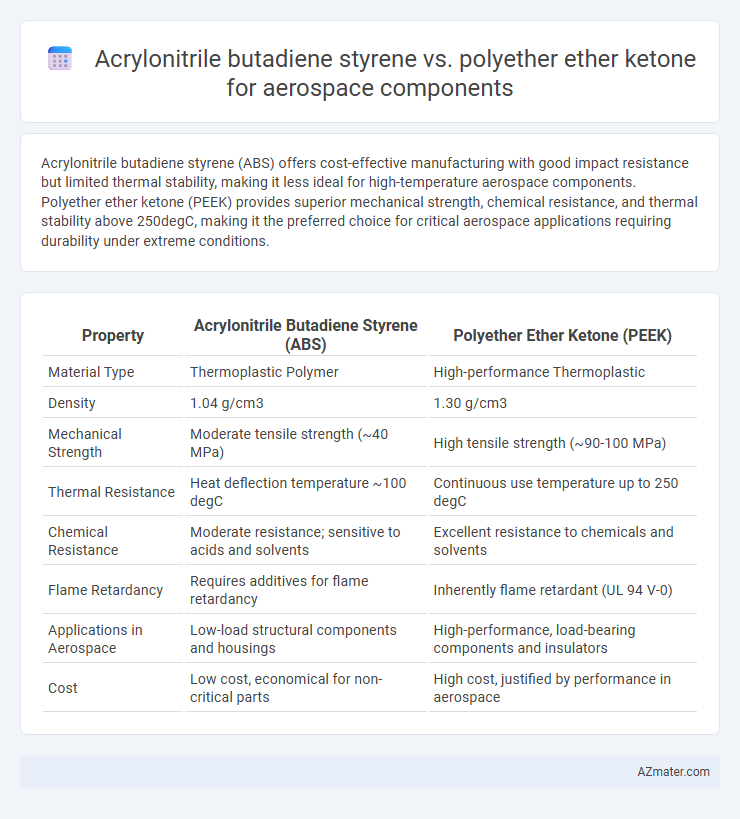Acrylonitrile butadiene styrene (ABS) offers cost-effective manufacturing with good impact resistance but limited thermal stability, making it less ideal for high-temperature aerospace components. Polyether ether ketone (PEEK) provides superior mechanical strength, chemical resistance, and thermal stability above 250degC, making it the preferred choice for critical aerospace applications requiring durability under extreme conditions.
Table of Comparison
| Property | Acrylonitrile Butadiene Styrene (ABS) | Polyether Ether Ketone (PEEK) |
|---|---|---|
| Material Type | Thermoplastic Polymer | High-performance Thermoplastic |
| Density | 1.04 g/cm3 | 1.30 g/cm3 |
| Mechanical Strength | Moderate tensile strength (~40 MPa) | High tensile strength (~90-100 MPa) |
| Thermal Resistance | Heat deflection temperature ~100 degC | Continuous use temperature up to 250 degC |
| Chemical Resistance | Moderate resistance; sensitive to acids and solvents | Excellent resistance to chemicals and solvents |
| Flame Retardancy | Requires additives for flame retardancy | Inherently flame retardant (UL 94 V-0) |
| Applications in Aerospace | Low-load structural components and housings | High-performance, load-bearing components and insulators |
| Cost | Low cost, economical for non-critical parts | High cost, justified by performance in aerospace |
Introduction to Aerospace Polymers
Acrylonitrile butadiene styrene (ABS) and Polyether ether ketone (PEEK) are critical aerospace polymers with distinct performance profiles. ABS offers cost-effective, impact-resistant solutions for non-structural interior components, while PEEK provides exceptional thermal stability, chemical resistance, and mechanical strength suitable for high-demand aerospace structural parts. The choice between ABS and PEEK depends on application requirements, balancing factors like temperature endurance, mechanical load, and environmental exposure within aerospace design constraints.
Overview of Acrylonitrile Butadiene Styrene (ABS)
Acrylonitrile Butadiene Styrene (ABS) is a thermoplastic polymer known for its toughness, impact resistance, and ease of fabrication, making it a common material in aerospace component prototyping and interior applications. Its chemical structure combines acrylonitrile for chemical resistance, butadiene for toughness, and styrene for rigidity and processability. Although ABS offers cost-effective manufacturing and good mechanical properties, it has lower thermal stability and chemical resistance compared to high-performance polymers like Polyether ether ketone (PEEK).
Overview of Polyether Ether Ketone (PEEK)
Polyether ether ketone (PEEK) is a high-performance thermoplastic widely utilized in aerospace components due to its exceptional thermal stability, mechanical strength, and chemical resistance. Compared to acrylonitrile butadiene styrene (ABS), PEEK offers superior dimensional stability and can withstand continuous operating temperatures up to 250degC, making it ideal for demanding aerospace environments. Its excellent fatigue resistance and resistance to hydrolysis extend component lifespan in harsh aerospace conditions, ensuring reliability and safety in critical applications.
Mechanical Strength Comparison: ABS vs PEEK
Acrylonitrile butadiene styrene (ABS) exhibits moderate tensile strength typically around 40 MPa, making it suitable for non-structural aerospace components with lower mechanical demands. In contrast, Polyether ether ketone (PEEK) offers superior mechanical strength, with tensile values exceeding 90 MPa and exceptional resistance to fatigue and impact, crucial for high-performance aerospace applications. PEEK's high thermal stability and chemical resistance further enhance its suitability for critical aerospace components compared to ABS.
Thermal Stability and Heat Resistance
Acrylonitrile butadiene styrene (ABS) offers moderate thermal stability with a heat deflection temperature around 100degC, making it suitable for less demanding aerospace applications. Polyether ether ketone (PEEK) demonstrates exceptional thermal stability and heat resistance, maintaining structural integrity at temperatures above 250degC, which is critical for high-performance aerospace components exposed to extreme conditions. The superior heat resistance and mechanical properties of PEEK ensure reliable performance in aerospace environments where long-term exposure to elevated temperatures is required.
Chemical Resistance in Aerospace Environments
Acrylonitrile butadiene styrene (ABS) offers moderate chemical resistance suitable for less demanding aerospace environments, effectively withstanding common fuels and lubricants but vulnerable to strong solvents and high-temperature degradation. Polyether ether ketone (PEEK) demonstrates superior chemical resistance, maintaining structural integrity when exposed to aggressive aerospace chemicals, high temperatures, and oxidative conditions. This distinction makes PEEK the preferred choice for aerospace components requiring long-term durability against harsh chemical exposure and extreme environmental conditions.
Weight and Density Considerations
Acrylonitrile butadiene styrene (ABS) features a density around 1.04 g/cm3, offering a lightweight option suitable for non-structural aerospace components where weight savings are critical. Polyether ether ketone (PEEK) has a higher density of approximately 1.3 g/cm3 but compensates with exceptional mechanical strength and thermal stability, making it ideal for high-performance aerospace parts under demanding conditions. Weight-sensitive aerospace designs benefit from ABS's lower density, while applications requiring durability and chemical resistance often prioritize PEEK despite its comparatively higher weight.
Cost Analysis: ABS vs PEEK in Aerospace
Acrylonitrile butadiene styrene (ABS) offers significantly lower material and processing costs compared to Polyether ether ketone (PEEK), making it a budget-friendly option for non-critical aerospace components. PEEK, however, provides superior thermal stability, chemical resistance, and mechanical strength, justifying its higher price in high-performance aerospace applications where durability and safety are paramount. The cost differential between ABS and PEEK can exceed 10 times, influencing material selection based on component function and lifecycle requirements in aerospace engineering.
Processability and Manufacturing Methods
Acrylonitrile butadiene styrene (ABS) offers superior processability with ease of injection molding and thermoforming, making it suitable for rapid prototyping and complex shapes in aerospace components. Polyether ether ketone (PEEK), while more challenging to process due to its high melting point and rigidity, requires specialized manufacturing methods like high-temperature injection molding and compression molding that ensure exceptional mechanical strength and chemical resistance. Manufacturing aerospace parts with PEEK demands precise temperature control and slower cycle times, whereas ABS allows faster production cycles with lower equipment cost.
Aerospace Application Suitability and Recommendations
Acrylonitrile butadiene styrene (ABS) offers cost-effective ease of manufacturing and good impact resistance, suitable for non-structural aerospace components such as interior panels and housings. Polyether ether ketone (PEEK) provides superior thermal stability, chemical resistance, and mechanical strength, making it ideal for critical aerospace parts exposed to harsh environments and high mechanical stress. For aerospace applications demanding long-term durability and performance under extreme conditions, PEEK is recommended, while ABS is preferable for low-load, decorative, or prototype components.

Infographic: Acrylonitrile butadiene styrene vs Polyether ether ketone for Aerospace component
 azmater.com
azmater.com